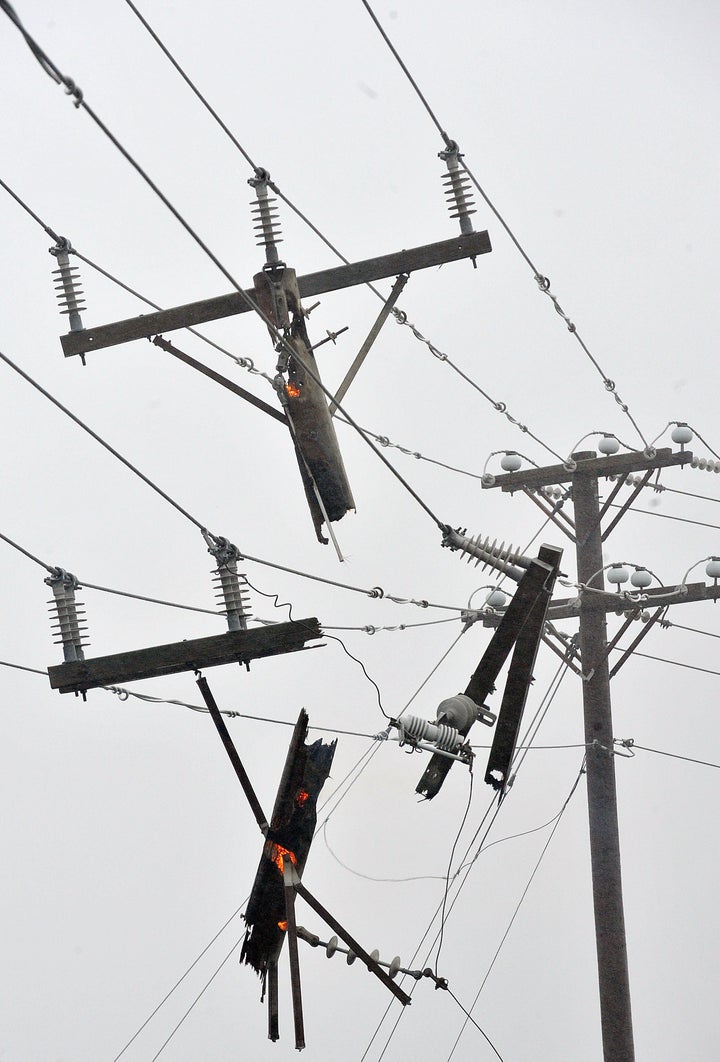
When I was out in the Cook Islands, on my way to winning the 13th season of the television series Survivor, I made several misguided attempts to build a fire by rubbing two sticks together. It usually didn't work out so well. After investing a few hours' worth of blood, sweat, and tears, the only thing I'd have to show for my efforts was a bruised ego and a newfound appreciation for the plentiful and readily available energy that most of us take for granted every day.
Americans on average are the biggest consumers of energy on the planet, and keeping the power that we need flowing is a monumental undertaking. As the host of the new PBS series America Revealed, I've had the chance to witness firsthand the enormous scale of America's electric grid and the vast energy infrastructure that feeds it. At one point during the taping of our third episode, "Electric Nation," which airs on Wednesday at 10:00 pm (EST), I climbed to the top of a 300-foot-tall wind turbine and rappelled down one of its gigantic blades, nervously following the directions of a repairman who does this sort of thing for a living. The tower that had looked so elegant from a distance was absolutely mammoth up-close, and I was awed by the fact that this was just one of 36,000 wind turbines that dot the American landscape and provide just a tiny portion of our nation's electrical needs.
The modern electric grid -- which has been called the largest and most complex machine on the planet -- began in lower Manhattan on September 4, 1882, when Thomas Edison switched on America's first central power plant. It provided electricity to just 400 electric bulbs in less than one square mile of New York City.
Today, nearly 6,000 generating plants and more than 200,000 miles of high-tension transmission lines supply power across our nation's electric grid. These plants are fueled by everything from nuclear power and natural gas, to renewables like solar and wind. But the single greatest source of power remains coal, which supplies nearly half of America's electricity.
A visit to Black Thunder Mine, one of the biggest coal-mining operations in the nation, immediately conveyed the scale necessary to keep up with demand. Located in Wyoming, which produces more coal than any other state in the nation, Black Thunder is literally the Grand Canyon of Coal.
The dump trucks that work the pits look like behemoth Tonka trucks on steroids. Standing almost two stories tall and holding up to 174 tons of coal, each truck can transport enough coal on a single trip to heat a typical American home for 40 years. The trains that carry the coal from Black Thunder to destinations across the country can stretch over a mile-and-a-half in length.
Interestingly, America's growing appetite for electricity isn't being driven by industry so much as by people like you and me. In fact, American homes and offices overtook American industry as the larger consumers of electricity back in 1994. Today, our homes contain on average 26 electronic devices, all requiring more and more electricity to maintain our high-tech way of life.
Yet despite our increasing demand for energy, Americans waste a staggering amount of it. I flew over Cleveland in a small plane with thermal-mapping equipment that identifies wasted energy in weirdly mesmerizing color patterns -- with bright orange depicting the most flagrant waste. The result was eye-popping: the city appeared on the screen like an inferno.
Almost half of the homes in Cleveland were built before 1950, and on average they are 40 percent less efficient than homes built in the last 10 years. But even better-insulated newer homes lose a large amount of energy because of their increasingly larger sizes. All these inefficiencies add up, costing the nation nearly $60 billion a year.
The extent of this waste, combined with the sheer magnitude of our energy needs, initially made me skeptical as to whether ordinary people could hope to effect meaningful change. But on my journey, I also met several individuals who were making a difference in their own communities. Their efforts, starting at the grass-roots level, gave me a real sense of optimism.
I met a dairy farmer in Vermont who is generating "cow power" -- electricity produced using the methane gas from manure. I visited an inner-city pastor in Washington, DC who had placed solar panels on the roof of his church, reducing the electricity bill by $400 per month. I worked with environmentally conscious homeowners to install solar panels on top of their homes.
When I first saw these people, I applauded their initiative but quietly questioned how their efforts could even begin to make a dent in solving our country's energy challenges. Indeed, it would take more than four million cows to equal the output of just one nuclear power plant. But after spending time with them, I realized that their efforts weren't just about energy production. They were engaging their neighbors in thinking more broadly about why we need energy, what it costs and how much we waste. They were producing energy -- renewable energy -- but more importantly they were teaching members of their communities to value the energy that we take for granted, to adopt a different mindset and to make changes in their own lives. "We all have to start somewhere," said one person I met. "And this is how I can start -- by leading from example."
The one person I would most loved to have interviewed, but obviously couldn't, is the man who started it all -- the father of the modern electric grid. More than anyone else, Thomas Edison was the architect of our energy-driven society. Yet ironically, he saw more clearly than anyone else the long-term need to harness renewable energy sources. In the final year of his life, Edison confided to his friend Henry Ford, "We are like tenant farmers chopping down the fence around our house for fuel when we should be using nature's inexhaustible sources of energy -- sun, wind and tide." Eighty years later, we have expanded Edison's electric machine across every corner of our country. But we are still striving to fulfill his vision.
The author, a lawyer, is the host of PBS's America Revealed airing nationally on Wednesday evenings at 10:00 pm (EST) through May 2nd.
